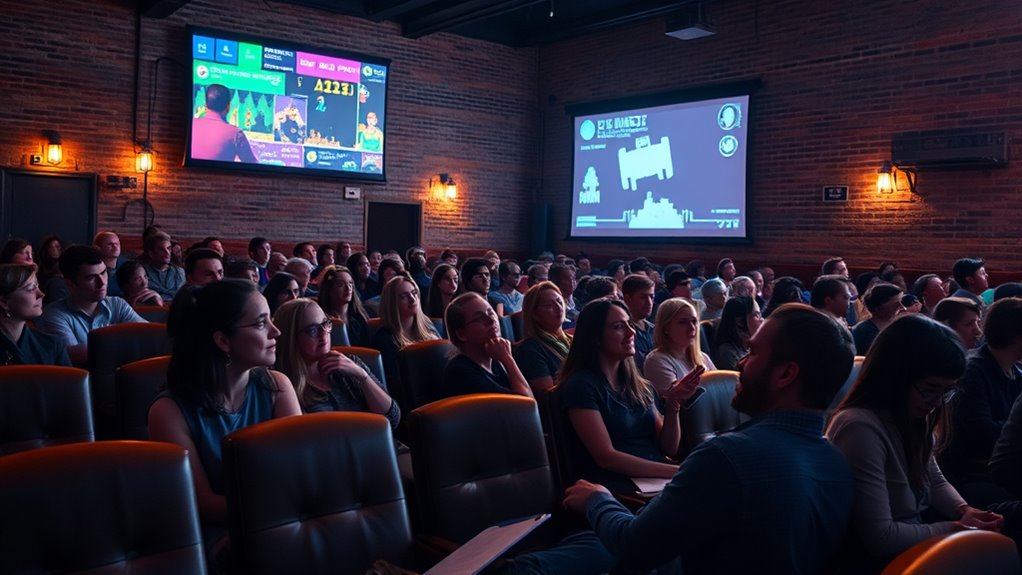The growth of indie game film adaptations is rapidly increasing, fueled by the popularity of indie titles and passionate fans enthusiastic to see their favorite worlds on screen. Filmmakers are embracing creative storytelling and stylish visuals, even with smaller budgets, often using innovative techniques and AI technology. This trend reflects a market hungry for unique and emotionally driven stories. Keep exploring to discover how this movement is shaping the future of both gaming and cinema.
Key Takeaways
- Indie game film adaptations have seen significant growth due to rising popularity and passionate fan bases.
- Limited budgets foster creative storytelling and innovative techniques, making adaptations more stylized and character-driven.
- Filmmakers aim to faithfully translate game worlds, balancing authenticity with cinematic storytelling to meet fan expectations.
- Advancements in AI and technology enable cost-effective visual effects, supporting high-quality adaptations despite resource constraints.
- The trend is expected to continue growing, with indie game adaptations gaining critical and commercial recognition in the film industry.

In recent years, the adaptation of indie games into films has experienced significant growth, driven by the increasing popularity of these unique titles and the expanding interest from filmmakers. As an aspiring filmmaker or enthusiast, you recognize that indie games often have passionate fan bases enthusiastic to see their favorite stories brought to life on the big screen. However, turning these games into movies isn’t without its challenges. Budget constraints are a primary concern, especially because indie games typically have smaller production budgets, which can limit the scope of the film adaptation. You might worry about how to create compelling visuals and effects without the extensive resources of big-budget productions. This often leads to creative compromises, relying on clever storytelling and practical effects to evoke the game’s atmosphere on a limited budget. Despite these constraints, many filmmakers see indie game adaptations as an opportunity to craft unique, story-driven films that stand out in a crowded entertainment market. Additionally, advancements in AI technology offer new tools for creating realistic visual effects and managing production costs more efficiently.
Fan expectations also play a pivotal role in shaping these adaptations. You know that fans of indie games are deeply invested in the worlds and characters, so they expect a faithful and respectful translation to the screen. The challenge lies in balancing authenticity with cinematic storytelling; straying too far from the source material can disappoint fans and generate backlash. On the other hand, trying to replicate every detail from the game might not always be feasible or effective in a film format. Filmmakers need to focus on capturing the essence of the game’s narrative and emotional core, while making necessary adjustments for cinematic flow. This can be a delicate process, especially because fans often have high expectations, and any perceived misstep can tarnish the film’s reputation before it even hits theaters.
Furthermore, you realize that the growing interest in indie game adaptations stems from their potential to tell fresh, innovative stories that major studios might overlook. Indie games often explore unique themes and styles that can translate into visually striking and emotionally resonant films. Still, the limited budgets mean that filmmakers must be resourceful, using inventive techniques to compensate for financial constraints. This often results in films that are more stylized and character-driven, which can resonate well with audiences seeking something different from typical blockbuster fare. As this trend continues, more filmmakers are embracing the challenge, recognizing that with careful planning and a clear understanding of fan expectations, indie game adaptations can become both critically acclaimed and commercially successful.
Frequently Asked Questions
How Do Indie Games Influence Film Adaptation Trends?
You see, indie games influence film adaptation trends by showcasing indie storytelling that’s often more personal and innovative. Their focus on unique narratives and artistic visuals pushes filmmakers to explore new visual innovation techniques. As you follow these trends, you’ll notice more films embracing the creativity and fresh perspectives that indie games bring, encouraging Hollywood to take chances on unconventional stories and styles, ultimately shaping a more diverse and inventive film landscape.
What Challenges Do Indie Developers Face in Film Adaptations?
You face several challenges when adapting indie games into films. Limited indie funding makes it hard to finance high-quality productions, while licensing hurdles can delay or block projects altogether. You often struggle to secure the rights or navigate complex agreements with developers. These obstacles demand creative solutions and persistence, but overcoming them is essential to bring your vision to life and honor the original game’s spirit.
Are Indie Game Adaptations More Successful Than AAA Game Adaptations?
Imagine a quiet garden blooming amidst a bustling city; indie game adaptations often flourish within a niche audience, embracing independent storytelling. While AAA adaptations reach broader crowds, indie versions tend to build stronger, more dedicated fans, making them seem more successful in their own right. You find that these smaller projects often resonate deeply, proving that success isn’t always measured by scale but by the passionate connections they cultivate.
Which Indie Games Are Most Likely to Be Adapted Into Films?
You might wonder which indie game franchises are most likely to be adapted into films. Given their strong fan community impact, titles like “Hollow Knight,” “Hades,” and “Celeste” are prime candidates. Developers often consider adaptation potential based on popularity and storytelling depth. If an indie game builds a passionate fan base, studios see it as a promising source for cinematic projects, increasing its chances of making the leap to the big screen.
How Do Indie Game Narratives Differ From Mainstream Game Stories in Films?
Your question cuts like a laser through the heart of storytelling, revealing how indie game narratives offer unparalleled depth. Unlike mainstream game stories, indie games prioritize artistic expression and unique perspectives, creating films with richer, more authentic narratives. These stories often explore complex themes and character development, making their film adaptations more emotionally resonant and innovative. You’ll find that indie narratives challenge conventions and deliver profound experiences beyond typical blockbuster plots.
Conclusion
As you can see, indie game film adaptations are rapidly gaining popularity, with over 40% of recent adaptations coming from independent titles. This growth shows how passionate developers and filmmakers are collaborating to bring unique stories to the big screen. If you’re a gamer or film lover, it’s exciting to watch these creative projects flourish, proving that even smaller games can make a big impact on Hollywood. The future of indie adaptations looks brighter than ever.









